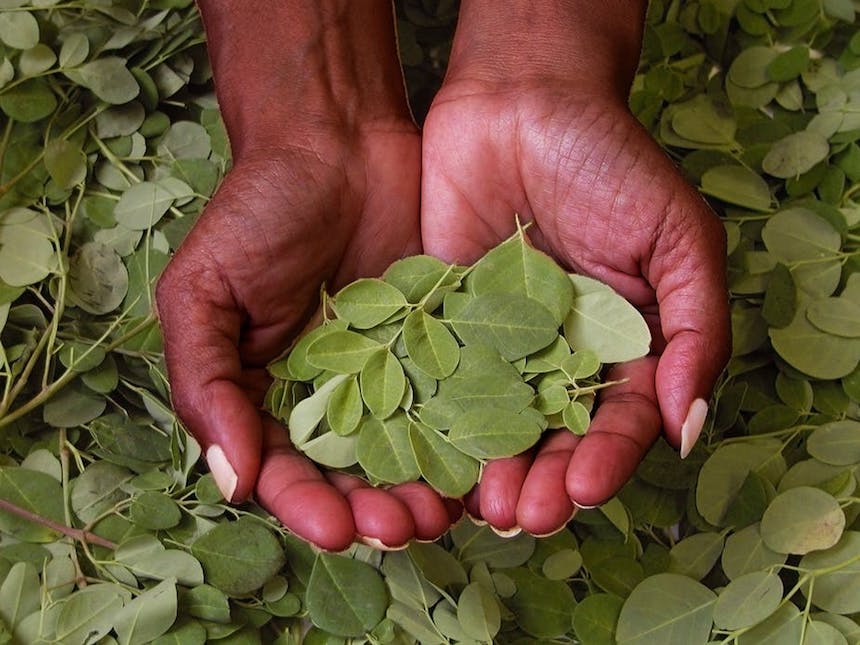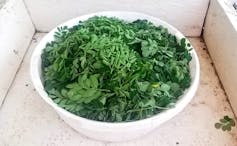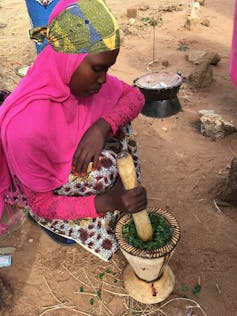
If plants could be superheroes, the Moringa (Moringa oleifera) tree would be one of them. Although native to the foothills of the Himalayas in India, moringa can thrive in most tropical and subtropical regions. It is drought tolerant, grows rapidly, has leaves that can be used as a biofertiliser, and has seeds that can help purify water. Today, moringa is most commonly found in India and the Philippines but its cultivation is increasing throughout Asia, Africa, Central America, and the Caribbean.
Even more interesting about this tree, is that it’s a food, a vegetable, and a medicine. Every part of the tree can be consumed; leaves and young fruits (pods) as food; and the seeds, bark, flowers, and roots as medicine.
The leaves are highly nutritious. Once harvested and dried, they contain 30% protein, all essential amino acids, and have abundant levels of vitamins and minerals.
The trees have a natural defence mechanism against environmental stress and pests. These are unique chemical compounds, known as phytochemicals, which include antioxidants and defence compounds. When consumed these compounds they also protect people against various conditions and diseases.
As a postdoctoral research at Rutgers University working with botanicals to treat obesity and diabetes, we demonstrated a simple way to harness the potent anti-inflammatory compounds in moringa leaves.
Moringa’s safety and efficacy have been reviewed, and have shown promise for the management of diabetes and risk of cardiovascular diseases.
How it works
Many phytochemicals, especially plant defence compounds used to ward off insects, are stored as inactive compounds. When the leaves are crushed, or chewed by an insect, an enzymatic reaction occurs, releasing the activated compound. While these can act as a deterrent to bug, tasting bitter or spicy, these compounds act as a potent anti-inflammatory agents in our body.
Moringa leaves.Carrie Waterman
The way it works is that when we’re sick, or have an underlying health condition like cancer, diabetes, or obesity, our bodies overreact and cause chronic inflammation. This constant inflammation throws the body off balance as it’s always in fight mode. While acute inflammation can help the body heal, like when you cut your finger, chronic inflammation can be detrimental to health because the immune system is over working. Inflammation can also cause improper processing of sugars and toxins that we are exposed to. The phytochemicals from moringa can help reduce this inflammation.
The bioactive compounds in moringa are called isothiocyanates (ITCs) and are similar to ones found in broccoli, cabbage and rocket – giving them a little peppery taste. We were able to patent a simple process of crushing the leaves when fresh, to release the active ITCs, and then dry them to a powder containing some of the most beneficial plant compounds for human health.
We showed their ability to reduce chronic inflammation, blood sugar levels, cholesterol, obesity and inflammatory bowel disorders in both cellular and animal models.
Increasing awareness
Although moringa has been consumed in South East Asia for centuries, its introduction to the rest of the world has been slow. Scientific research on the plant’s benefits has also been limited, although an increase in academic publications has grown significantly since 2000. With rising pressures of population growth and climate change causing increased food and nutritional security, particularly in Africa, moringa offers a tool to address these issues.
People’s awareness and concern for their health have allowed beneficial plants to gain more exposure. Over the past five years, awareness of moringa leaves as a healthy green vegetable has begun to emerge. Not just as packaged and jarred leaf powders in Nairobi supermarkets and farmers markets, but also in US and European “superfood markets.”
Crushing moringa leaves. Carrie Waterman
Fresh moringa leaves are tasty in salads, soups, on eggs, and anything savoury. But the fresh leaves are fairly perishable and are ideally consumed within a day of harvesting. The immature pods can also be eaten like green beans, and are often found in soups. The dried leaf powder offers an alternative to those who can’t grow moringa in their backyard or have access to a farm. The dried powder can be added to porridge, smoothies, tea, soups, and as a herb to any meal after it has been cooked. For those who don’t like the spicy, “healthy” taste, moringa powder is also available in capsules and tea blends.
In the past year, I’ve purchased over 15 commercial moringa leaf powder products in Kenya, including ME Moringa for Life which is already exporting to Europe with organic certification. Other companies entering the export market include Botanic Treasures and Kili Natural.
![]() New moringa products and companies are certainly on the rise, but caution for high quality products is warranted. Most herbal products in the US and Kenya are not strictly regulated, leaving room for additions, alterations, and contamination as potential problems. Additionally the soil, farming techniques, and processing of the leaves can affect its quality and nutrient content. Finding a high-quality moringa powder may require a little research and contacting the company. Or you could buy some seeds and grow some of your own superheroes at home.
New moringa products and companies are certainly on the rise, but caution for high quality products is warranted. Most herbal products in the US and Kenya are not strictly regulated, leaving room for additions, alterations, and contamination as potential problems. Additionally the soil, farming techniques, and processing of the leaves can affect its quality and nutrient content. Finding a high-quality moringa powder may require a little research and contacting the company. Or you could buy some seeds and grow some of your own superheroes at home.
Carrie Waterman, Assistant Researcher, University of California, Davis
This article was originally published on The Conversation. Read the original article.



